User login
OBG Management September Poll
[polldaddy:10080640]
[polldaddy:10080640]
[polldaddy:10080640]
In an uncertain health care climate, will you advocate for women's health outside your office?
In her February 2017 article, Lucia DiVenere interviewed the current and incoming ACOG Presidents, Drs. Thomas Gellhaus and Haywood Brown. The Presidents called for advocacy on behalf of the “melting pot” of women’s health specialists and subspecialists. “We cannot sit on the sidelines and expect others to speak for us,” said Dr. Gellhaus. “If we are not part of the solution, then we need to cede our future to others and have no right to complain about the result. Our members need to commit to advocating outside their exam rooms.”
Answer the poll below:
[polldaddy:9703185]
Share your thoughts! Send your Letter to the Editor to [email protected]. Please include your name and the city and state in which you practice.
In her February 2017 article, Lucia DiVenere interviewed the current and incoming ACOG Presidents, Drs. Thomas Gellhaus and Haywood Brown. The Presidents called for advocacy on behalf of the “melting pot” of women’s health specialists and subspecialists. “We cannot sit on the sidelines and expect others to speak for us,” said Dr. Gellhaus. “If we are not part of the solution, then we need to cede our future to others and have no right to complain about the result. Our members need to commit to advocating outside their exam rooms.”
Answer the poll below:
[polldaddy:9703185]
Share your thoughts! Send your Letter to the Editor to [email protected]. Please include your name and the city and state in which you practice.
In her February 2017 article, Lucia DiVenere interviewed the current and incoming ACOG Presidents, Drs. Thomas Gellhaus and Haywood Brown. The Presidents called for advocacy on behalf of the “melting pot” of women’s health specialists and subspecialists. “We cannot sit on the sidelines and expect others to speak for us,” said Dr. Gellhaus. “If we are not part of the solution, then we need to cede our future to others and have no right to complain about the result. Our members need to commit to advocating outside their exam rooms.”
Answer the poll below:
[polldaddy:9703185]
Share your thoughts! Send your Letter to the Editor to [email protected]. Please include your name and the city and state in which you practice.
November 2008 Instant Poll Results
Which of these wardrobe items would you ban from the hospital?*
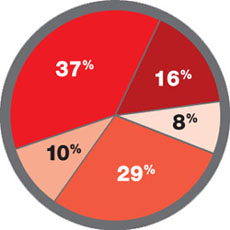
37% Jewelry on the hand and wrist
16% White coat
8% Long-sleeve shirt
29% Long necktie
10% Wrist watch
* FOR MEDICAL STAFF
Which of these wardrobe items would you ban from the hospital?*

37% Jewelry on the hand and wrist
16% White coat
8% Long-sleeve shirt
29% Long necktie
10% Wrist watch
* FOR MEDICAL STAFF
Which of these wardrobe items would you ban from the hospital?*

37% Jewelry on the hand and wrist
16% White coat
8% Long-sleeve shirt
29% Long necktie
10% Wrist watch
* FOR MEDICAL STAFF
October 2008 Instant Poll Results
BIOIDENTICAL HT: WHERE DO YOU STAND?
A 54-year-old woman, recently menopausal, complains of hot flushes that make her miserable. After an evaluation, including an endocrine work-up, you recommend hormone therapy (HT). She promptly asks about bioidentical hormones, which she has read about on the Internet and heard about from friends. In your practice, the next step would be to:
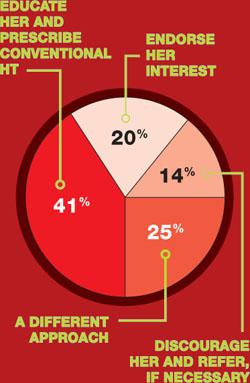
COMMENTS
“I would educate her on the facts about bioidenticals but, if she insists, I would let her have them.”
“I employ a combination of the three options.”
“As a specialty, we need to be clear on terminology: There are pharmaceutical bioidentical hormones.”
“I explain to patients that estradiol—the medication in Estrace, Vivelle, etc.—is bioidentical.”
BIOIDENTICAL HT: WHERE DO YOU STAND?
A 54-year-old woman, recently menopausal, complains of hot flushes that make her miserable. After an evaluation, including an endocrine work-up, you recommend hormone therapy (HT). She promptly asks about bioidentical hormones, which she has read about on the Internet and heard about from friends. In your practice, the next step would be to:

COMMENTS
“I would educate her on the facts about bioidenticals but, if she insists, I would let her have them.”
“I employ a combination of the three options.”
“As a specialty, we need to be clear on terminology: There are pharmaceutical bioidentical hormones.”
“I explain to patients that estradiol—the medication in Estrace, Vivelle, etc.—is bioidentical.”
BIOIDENTICAL HT: WHERE DO YOU STAND?
A 54-year-old woman, recently menopausal, complains of hot flushes that make her miserable. After an evaluation, including an endocrine work-up, you recommend hormone therapy (HT). She promptly asks about bioidentical hormones, which she has read about on the Internet and heard about from friends. In your practice, the next step would be to:

COMMENTS
“I would educate her on the facts about bioidenticals but, if she insists, I would let her have them.”
“I employ a combination of the three options.”
“As a specialty, we need to be clear on terminology: There are pharmaceutical bioidentical hormones.”
“I explain to patients that estradiol—the medication in Estrace, Vivelle, etc.—is bioidentical.”
June 2008 Instant Poll Results
WHAT IS THE C-SECTION RATE AT YOUR HOSPITAL?
At my hospital, the overall cesarean delivery rate is:
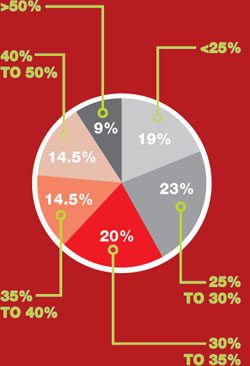
…and I think that this rate is: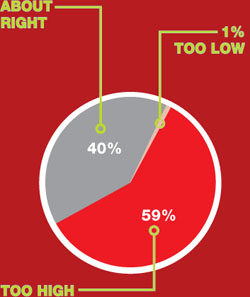
WHAT IS THE C-SECTION RATE AT YOUR HOSPITAL?
At my hospital, the overall cesarean delivery rate is:

…and I think that this rate is:
WHAT IS THE C-SECTION RATE AT YOUR HOSPITAL?
At my hospital, the overall cesarean delivery rate is:

…and I think that this rate is:
May 2008 Instant Poll Results
FAILED HOME BIRTH, NOW IN THE ED
You are at the hospital, caring for your patients in labor, when a 32-year-old G3P2 with two prior cesarean section deliveries is brought to the emergency department in labor after a failed home birth.
“Will you assume care for this woman?” the nursing administrator asks you. Quickly! What would you do?
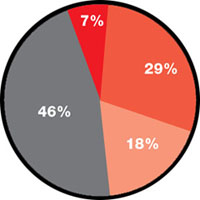
7% Refuse to accept responsibility for a high-risk patient whom you’ve never seen
29% Assume her care and recommend cesarean section
46% Assume her care and recommend cesarean section—plus, later, report the responsible midwife to the department of public health and her credentialing organization
18% Agree to assume her care as long as the hospital’s attorney and risk management team indemnify you
FAILED HOME BIRTH, NOW IN THE ED
You are at the hospital, caring for your patients in labor, when a 32-year-old G3P2 with two prior cesarean section deliveries is brought to the emergency department in labor after a failed home birth.
“Will you assume care for this woman?” the nursing administrator asks you. Quickly! What would you do?

7% Refuse to accept responsibility for a high-risk patient whom you’ve never seen
29% Assume her care and recommend cesarean section
46% Assume her care and recommend cesarean section—plus, later, report the responsible midwife to the department of public health and her credentialing organization
18% Agree to assume her care as long as the hospital’s attorney and risk management team indemnify you
FAILED HOME BIRTH, NOW IN THE ED
You are at the hospital, caring for your patients in labor, when a 32-year-old G3P2 with two prior cesarean section deliveries is brought to the emergency department in labor after a failed home birth.
“Will you assume care for this woman?” the nursing administrator asks you. Quickly! What would you do?

7% Refuse to accept responsibility for a high-risk patient whom you’ve never seen
29% Assume her care and recommend cesarean section
46% Assume her care and recommend cesarean section—plus, later, report the responsible midwife to the department of public health and her credentialing organization
18% Agree to assume her care as long as the hospital’s attorney and risk management team indemnify you
August 2008 Instant Poll Results
MARCH 2008
Coffee and conception—what’s your counsel?
A woman drinks 4 cups of caffeinated coffee daily but reports no other source of caffeine, which means that she consumes about 500 mg of caffeine a day. She tells you that she’s concerned about the impact of caffeine on a future pregnancy.
What would you say to this patient about her consumption of caffeine when she begins to try to conceive and, later, while she is pregnant?
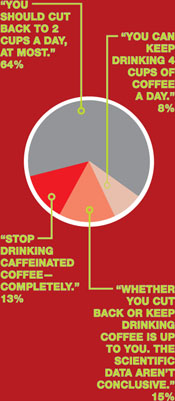
APRIL 2008
Failed weight loss: Take the next step
Your patient is a 27-year-old woman who has a body mass index of 41 and polycystic ovary syndrome. Her medications are an estrogen–progestin oral contraceptive and metformin, 1,500 mg/day.
She has tried to lose weight many times, without lasting success. She has consulted with nutritionists, personal trainers, and endocrinologists. The next step is yours:
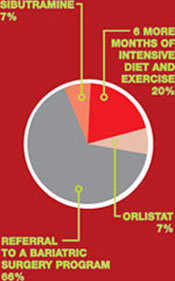
MARCH 2008
Coffee and conception—what’s your counsel?
A woman drinks 4 cups of caffeinated coffee daily but reports no other source of caffeine, which means that she consumes about 500 mg of caffeine a day. She tells you that she’s concerned about the impact of caffeine on a future pregnancy.
What would you say to this patient about her consumption of caffeine when she begins to try to conceive and, later, while she is pregnant?

APRIL 2008
Failed weight loss: Take the next step
Your patient is a 27-year-old woman who has a body mass index of 41 and polycystic ovary syndrome. Her medications are an estrogen–progestin oral contraceptive and metformin, 1,500 mg/day.
She has tried to lose weight many times, without lasting success. She has consulted with nutritionists, personal trainers, and endocrinologists. The next step is yours:

MARCH 2008
Coffee and conception—what’s your counsel?
A woman drinks 4 cups of caffeinated coffee daily but reports no other source of caffeine, which means that she consumes about 500 mg of caffeine a day. She tells you that she’s concerned about the impact of caffeine on a future pregnancy.
What would you say to this patient about her consumption of caffeine when she begins to try to conceive and, later, while she is pregnant?

APRIL 2008
Failed weight loss: Take the next step
Your patient is a 27-year-old woman who has a body mass index of 41 and polycystic ovary syndrome. Her medications are an estrogen–progestin oral contraceptive and metformin, 1,500 mg/day.
She has tried to lose weight many times, without lasting success. She has consulted with nutritionists, personal trainers, and endocrinologists. The next step is yours:

Instant Poll Results
JULY 2007
Have you been drilled recently to prepare for massive obstetric hemorrhage?
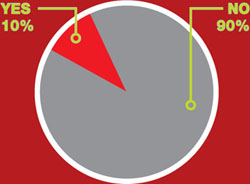
The Joint Commission recommends that labor and delivery services practice responding to common obstetric emergencies by using simulation training. Has your obstetric service had a simulation drill for massive obstetric hemorrhage during the past year?
SEPTEMBER 2007
Can you prognosticate the future of the specialty?
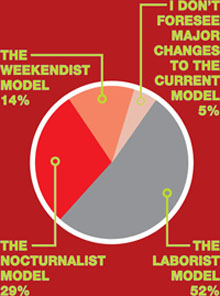
Gazing into the future, which of the following “-ist” models do you think ObGyn practices are most likely to heavily rely on to boost the career satisfaction of practicing obstetrician-gynecologists?
JULY 2007
Have you been drilled recently to prepare for massive obstetric hemorrhage?

The Joint Commission recommends that labor and delivery services practice responding to common obstetric emergencies by using simulation training. Has your obstetric service had a simulation drill for massive obstetric hemorrhage during the past year?
SEPTEMBER 2007
Can you prognosticate the future of the specialty?

Gazing into the future, which of the following “-ist” models do you think ObGyn practices are most likely to heavily rely on to boost the career satisfaction of practicing obstetrician-gynecologists?
JULY 2007
Have you been drilled recently to prepare for massive obstetric hemorrhage?

The Joint Commission recommends that labor and delivery services practice responding to common obstetric emergencies by using simulation training. Has your obstetric service had a simulation drill for massive obstetric hemorrhage during the past year?
SEPTEMBER 2007
Can you prognosticate the future of the specialty?

Gazing into the future, which of the following “-ist” models do you think ObGyn practices are most likely to heavily rely on to boost the career satisfaction of practicing obstetrician-gynecologists?